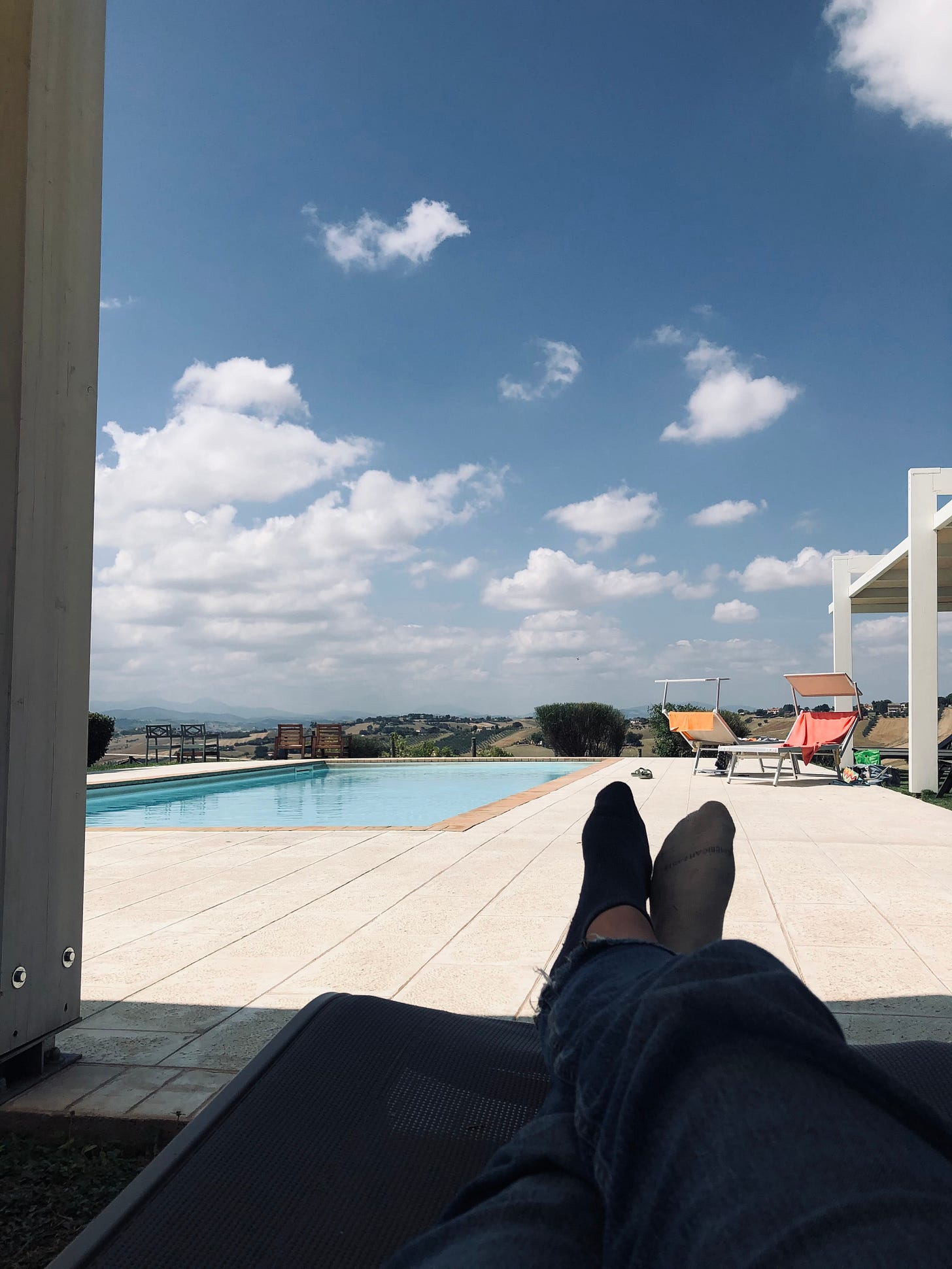Tenuta San Marcello
Harvest lunches and wheat stalk tattoos in the land of Verdicchio
Dall'alba al tramonto. From sunrise to sunset.
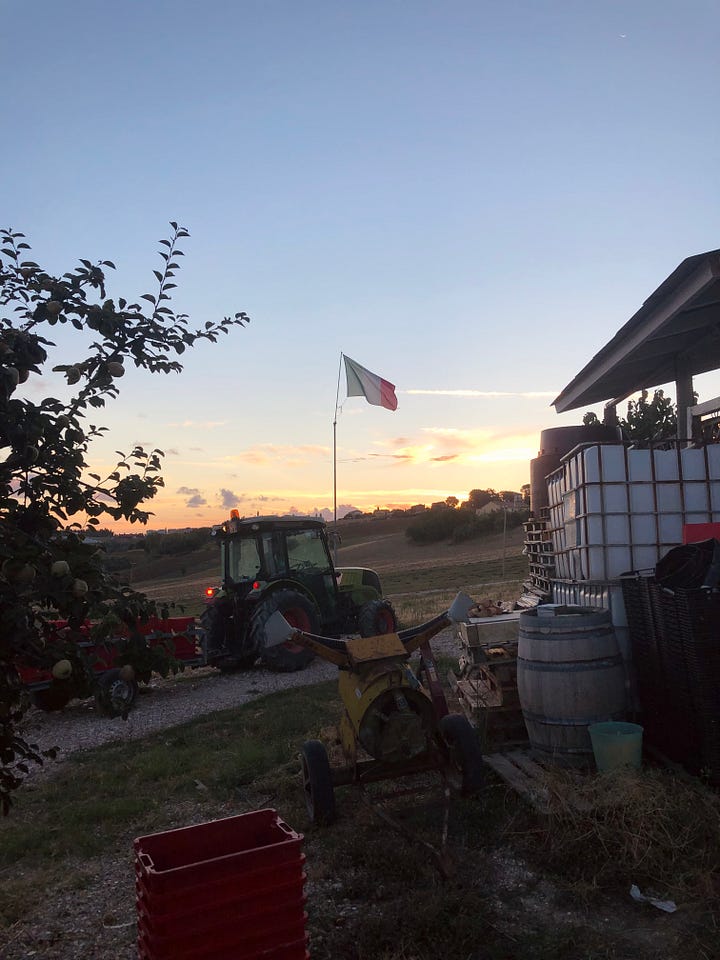
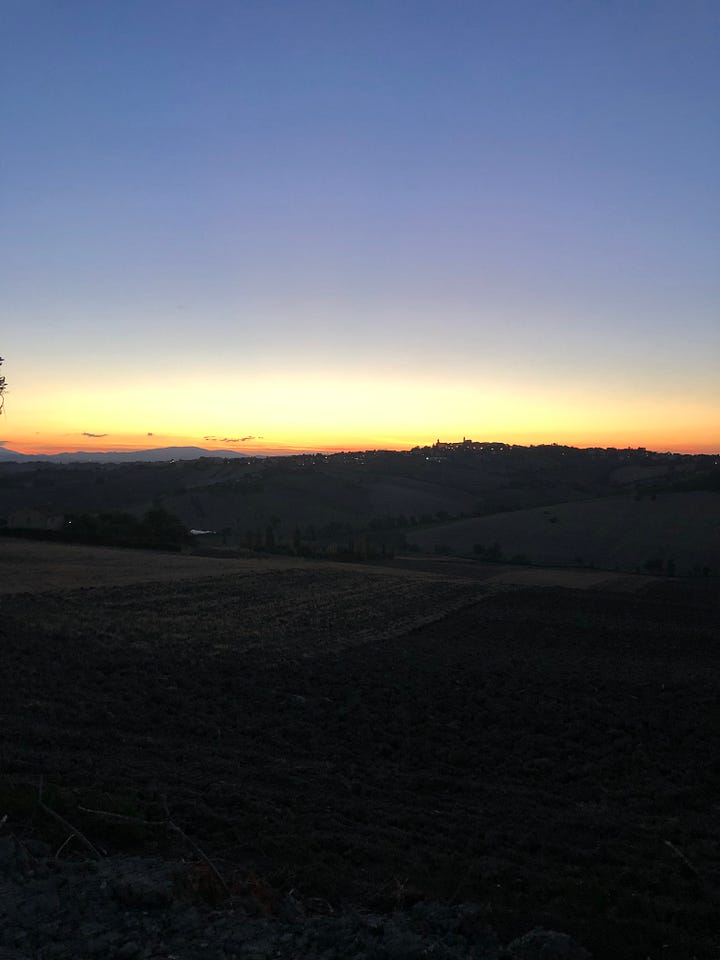
How do I stumble upon these random finds? I found information about Tenuta San Marcello on a Facebook group dedicated to posting jobs/part-time work for wineries around the world. I had been checking it regularly for last minute postings for harvest interns, workers, even day-laborers for picking grapes. When I first came to Italy, I knew I wanted to work a harvest in some way. Typically harvest begins in mid-late September in the Northen Hemisphere but I had seen many Instagram feeds from wineries in Italy suggesting that harvest may begin earlier than years prior (this was in 2022). This was due to the consistently hot temperatures through the summer and little rainfall. While I am usually disappointed about climate changes due to global warming, in this case it gave me an opportunity to have my harvest experience in some way or another.
We drove to the Tenuta, winding through the sunbaked hills of Jesi. I had never been to this side of the country before, but I could tell after 10 minutes that there was something remarkably peaceful about this region.
The owners of Tenuta San Marcello are Massimo and his wife Pascale. Pascale oversaw the Tenuta (agrotourismo) while Massimo managed winery operations. Fabio was introduced to me as the winemaker.
Massimo picked me up at the train station in Jesi, after one of the most grueling trains rides I had yet to ensure during my time in Italy. I accidentally bought a ticket for the regional train, which meant more stops, a longer trip and no air conditioning. Did I mention it was late-August? We drove to the Tenuta, winding through the sunbaked hills of Jesi. I had never been to this side of the country before, but I could tell after 10 minutes that there was something remarkably peaceful about this region. I had very few expectations for the week. I knew there was an agroturismo based on the photos on their Instagram, but I had no idea that winery was attached to it. On the property there was a pool and small independent apartments laid out around the property. The main “house” held the kitchen, bar, and the inside tables, but that evening, most of the tables were placed outside.
There were about five hectares of land, dedicated to Lacrima, and Verdicchio grapes. The plan for the next week was to pick grapes for their sparkling wine because their sparkling wines were made in the pet-nat style1. The grapes used for this style of wine need more acidity than fully mature grapes, hense the earlier picking date.
While Massimo was giving me to the tour, I was completely unaware of the fact that we were standing on were their giant amphorae eggs, which were stored underground, below the dining area outside.2


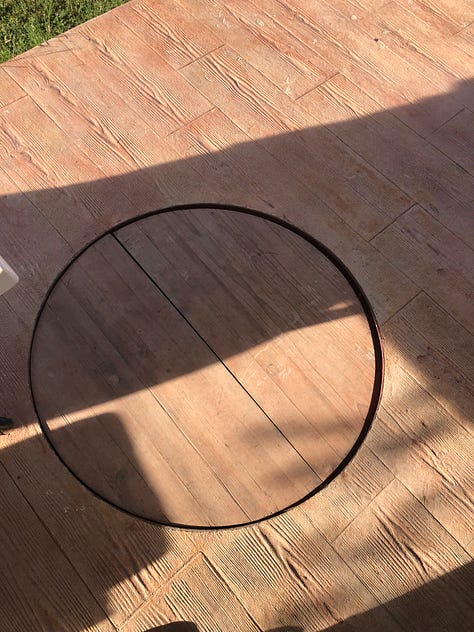
We took a moment to stir the pied de cuve which acts as the mother (starter) yeast, allowing for native fermentation. He said he started the concoction a few days ago and a few times a day he would mix the must with the juices. He stirred the pot's contents, incorporating more oxygen, bubbles, and thus life. That fermenting must will be used later as the main fermenting agent after the grapes are pressed and placed in their fermentation tank.
The artwork on the walls of the wine cellar was done by a friend of Massimo’s, and it followed and illustrated the entire winemaking process from the Lacrima grape crying (Lacrima directly translates to teardrop) to an illustration of a yeast eating sugar, farting out CO2 and peeing out alcohol. There is really no better way to describe the process.

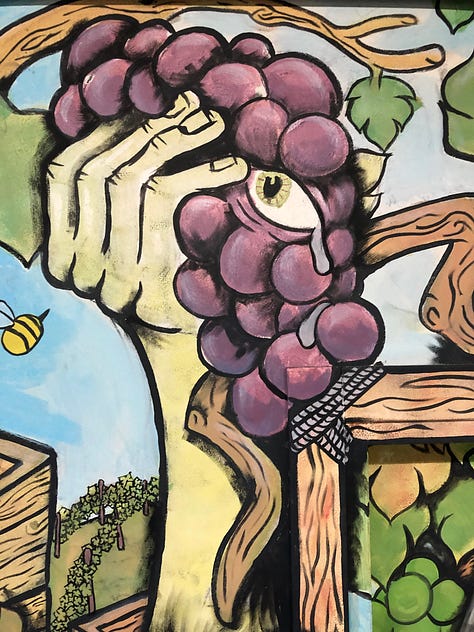
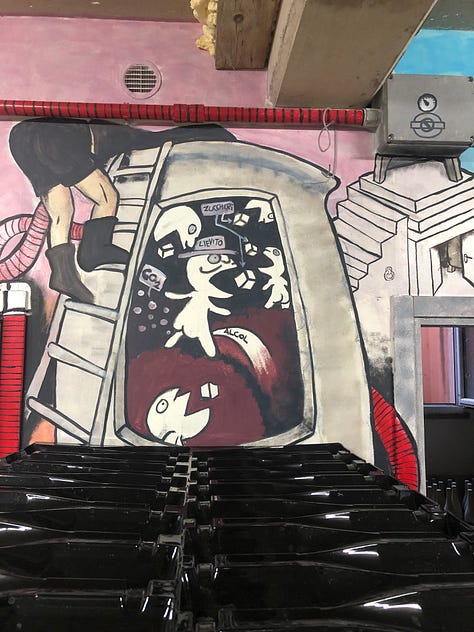
The sun was slowly setting, and I really wanted to get home, put sheets on my new bed, take a shower and get ready for the morning. I mapped it out and my phone suggested a thirty-minute walk. I asked my new roommate what the exact address of the apartment was, and she said she didn’t know. She said, “It’s above the above the church, and next to the bar, you can’t miss it.” I took her word for it and headed home.
It was a late summer evening; kids were playing soccer and riding bikes in the street in front of the bar while the parents and bar regulars watched on. I had the pleasure of experiencing so many towns and villages like this one throughout the summer. I could not help but smile and think that this side of Italy doesn’t exist for tourists, at least for now. I passed the bar when I heard something that sounded like “Tana,” and immediately stopped in my tracks. There was no way someone in this remote village knew who I was. I slowly turned around to see a girl standing right behind me. She asked me if I was Tana, and I responded yes, hesitantly, as I was still very confused how she knew my name. The girl responded quickly, and in perfect English, that her boyfriend is the winemaker for San Marcello, and they were sitting right over there, pointing to the nearby table. They said they knew I was coming in today and when they saw me walking it was obvious that I was ‘The American Girl.’ They invited me over for a drink, white wine with Campari over ice.
The first day was about learning my way around. I arrived at the winery early. I made a cup of coffee at the apartment and drank it on my walk to the Tenuta in my to-go coffee mug (how American). It was the end of August, and the air was getting noticeably cooler in the morning and late evening; a much-deserved break from the relentless July heat. I took a second coffee and small plate of food from the breakfast buffet available to guests staying on the property (I was not sure if that was allowed, but in my experience solo traveling, when you have the chance to eat, take it). I sat and watched the kittens and chickens play alongside each other on the grass. I almost brought a kitten back to Rome with me.
The first day of work included taking grape samples from the vineyard crushing them by hand to test the pH level. Fabio and I walked together for the first row, and he showed me how to select the grapes: random, but concise, alternating top of bunch, middle of bunch, bottom of bunch, right side of row, left side of row. To the untrained eye it would have looked like two adults whimsically walking through the vineyard picking grapes to snack on. Fabio popped grapes into his mouth every so often, as he told me his story about going to Oenology school near Milan where he is originally from, and he had been working at San Marcello for two years. He said he never really thought about winemaking or the wine industry at all until he saw that Oenology was offered as a concentration during his studies. He originally wanted to work in agriculture, he even had a tattoo of a wheat stalk on his arm. A good reminder to me that the food and wine I love starts out as one simple ingridient, and before that, one plant. He had worked harvest in Chile earlier that year and told me he was planning on working in New Zealand the next year. I was inspired by Fabio. He never complained, he never said no to helping me or the other girls when we had a question. (Along with myself there were two other girls that were helping us throughout the week). He took his time to explain and translate everything for us and seemed genuinely excited to learn how to say the words of the tools, machines, and methods in English.
The third day was the official first day of picking. We arrived at the Tenuta at 6 a.m and we were told to pick grapes on the side of the sunrise. Fabio said to leave at least two bunches on the vine, that way they could come back two weeks later when the grapes are fully mature and pick them for a late harvest wine. Fabio said it was important to pick low-hanging fruit now because ripe grapes are very vulnerable to birds, animals, and severe weather such as heavy summer rainstorms, extreme and heat. I asked why we were leaving grapes on the vine at all, it seemed improbable that there would be any grape remaining at all in two weeks, for there are too many unforeseeable factors. A month and a half later he sent me a photo with a grape bunch still hanging from the row we left. I guess the animals left some grapes for wine after all.
After six hours of picking, I relaxed by the pool while lunch was prepared. Lunch was provided every day and lunch was the redeeming quality that kept us all going. It is understood that Italian lunches are a big to-do, especially during harvest time. On most of the job postings I saw for positions working harvest, “the harvest lunches” were often a selling point. Some of the best meals I had while in Italy, I had at Tenuta San Marcello. I had staff meal the first night-parmigiana di melanzane, with freshly baked bread. One afternoon Massimo’s friends joined us for lunch and we ate under the olive trees-panzanella, caprese salad and an assortment of salumi. Pasta is usually the first course, followed by a protein and a side dish or two. I have this theory that a good lunch can make or break the day, and lunches here always made my day that much better. We always finished lunch with an espresso and Massimo, without fail, beamed when someone mentioned gelato. It was like he was waiting for someone to suggest it.
On my last day, Massimo sat down with me to have a interview about his experiences and ethos behind the sustainable measures implemented at Tenuta San Marcello. Massimo was a character; he had a demanding presence, standing at almost 6 foot 5 inches and always had a welcoming smile on his face. I always expect owners to be hands off, and more focused on relaxing with friends, and showing off the wine rather than making it themselves. Massimo was the opposite: he was with us every day picking grapes, driving the tractor, cleaning the machines, he even cooked lunch one day. During our interview we spoke about the difference between natural wine and sustainable wine, and how they are not the same thing, for natural wine can be made in an unsustainable way. He spoke a lot about the carbon footprint of the glass bottles. A topic that I originally planned to write my thesis on. He was very aware of the weight of the bottles and when distributing wine to other markets, there are a lot of carbon emissions involved in the transportation. He said in a perfect world he would like all the wines to be enjoyed on the property so he would not have to ship glass bottles at all. But like I have mentioned in other pieces, consumer markets' outside of Italy are fueling the Italian wine industry because of their higher spending power. Shipping wine is inevitable.He spoke about fermentation being the best way to preserve foods and making wine through fermentation is just a form of food preservation. In almost 10 years of working in wine, I had never heard someone describe wine so simply.
He spoke about fermentation being the best way to preserve foods and making wine through fermentation is just a form of food preservation. In almost 10 years of working in wine, I had never heard someone describe wine so simply.
The train station in Rome was a brutal reminder that life in the city and life in the countryside could not be more different. The air was heavy with cigarette smoke, and while that was not a new observation, I felt as though being out of Rome for a week had revitalized my system. I had clean air, great food, good company and sunshine for a week straight. While my body went through some hardships and my feet were sore, as I waited for my bus, I realized that I already missed it all. The week was chaotic but the five of us endured that week together. It was not perfect, but neither were we, and neither is wine. That is what makes it natural, it embodies the energy of the people involved in the process. Wine is the product of natural systems, all year the natural systems are taking place in the vineyard, but then, for a few weeks, the grapes' hard work is finished by a group of people. Whether we were qualified or not, we were all winemakers during that week. At Tenuta San Marcello, wine was not simply a byproduct of grapes, but a way to communicate their passion and perseverance towards sustainable living.
I also write a piece about Tenuta San Marcello and their unique natural x natural wine labels. Read it here!
Wine labels are not indicative of a wine’s naturalness
Natural wine labels have become just that, a symbol of alternative winemaking. It almost seems as though the label somehow gives a pass to be welcomed to the natural wine community. A fun, brightly colored, artistic label placed next to a traditional château and script label is obviously going to have consumers stop in their tracks and reach for the ‘fu…
Pet-nat is wine industry slang for pétillant naturel meaning naturally sparkling in French. The process is simple. The wine is bottled with low amounts of active yeast which continues to eat away the sugars while inside the bottle. This results in secondary fermentation inside the bottle and the CO2 is what makes the wine naturally sparkling. The grapes used for this style of wine need more acidity than fully mature grapes, hense the earlier picking date.
Amphora is an aging vessel made of terracotta. By storing it underground, the eggs remain temperature controlled.





